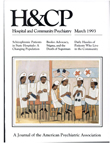Patients' Perceptions of Their Quality of Life 11 Years After Discharge From a State Hospital
Abstract
Fifty-three state hospital patients discharged to group homes in the community in 1978-79 were followed up at three and 11 years to assess their quality of life and several other dimensions of their community experience. Methods: A structured interview was used to obtain data on patients' perceptions of and degree of satisfaction with aspects of their lives one month before hospital discharge and at three and 11 years after. Group home staff rated patients' functioning at follow-up. Data on rehospitalizations over the 11-year period were collected. Results: At 11-year follow-up, 30 of the surviving 40 patients were living in noninstitutional settings: nine in independent or semi-independent settings and 21 in group homes. The 30 patients perceived that their quality of life outside the hospital bad improved in several ways, including the extent of their social networks, the quality of their living environment, and their capacity to meet basic needs. When data were averaged over the 11 years and corrected for the shorter time in the study of subjects who died, patients spent only 2.6 percent of the follow-up period in hospital. Only one patient at 11 years wanted to return to the hospital. Conclusions: The finding that even the small minority of patients who required multiple rehospitalizations preferred community life may have important clinical and policy implications for setting the threshold of hospital discharge.
Access content
To read the fulltext, please use one of the options below to sign in or purchase access.- Personal login
- Institutional Login
- Sign in via OpenAthens
- Register for access
-
Please login/register if you wish to pair your device and check access availability.
Not a subscriber?
PsychiatryOnline subscription options offer access to the DSM-5 library, books, journals, CME, and patient resources. This all-in-one virtual library provides psychiatrists and mental health professionals with key resources for diagnosis, treatment, research, and professional development.
Need more help? PsychiatryOnline Customer Service may be reached by emailing [email protected] or by calling 800-368-5777 (in the U.S.) or 703-907-7322 (outside the U.S.).



